Ginseng in the country and in the forest
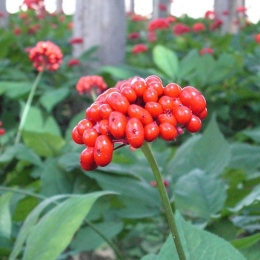
Ginseng is a medicinal plant with unsurpassed adaptogenic properties. Widely used in folk and oriental medicine. In Korea, China, Japan, and other countries, the cultivation of ginseng as a medicinal and edible plant is widespread. The traditions of growing ginseng go back centuries.
Content:
- Description of the botanical species
- Preparation and sowing of seeds and seedlings
- Seedling care
- Diseases and pests of ginseng
Description of the botanical species
perennial herbaceous plant family Araliaceae.
The plant has a tap-shaped, twisted root that looks like the figure of a bearded old man. The length of the root is up to 25 cm. The root is light yellow, white when cut. The leaves are palmate, elongated, collected in a whorl at the top of the stem, and look like a five-fingered palm.
Inflorescence umbrella, fruit drupe. Natural habitat: China, Tibet, Altai, Primorsky Krai. One species grows in North America. A total of 11 species are known and described. In Russia, it is very difficult to find a wild root due to annual poaching. But ginseng grown on a personal plot will contain the same medicinal substances, albeit in lower concentrations.
Preparation and sowing of seeds and seedlings
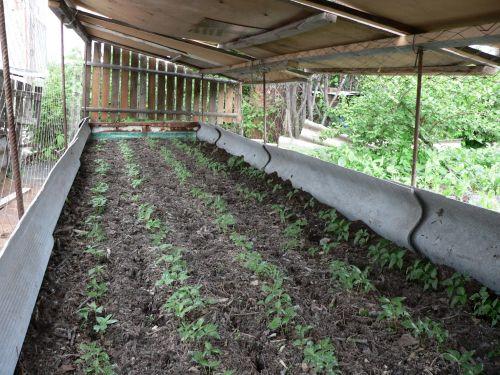
Currently, amateur ginseng growers successfully cultivate it in the gardens of Belarus, Ukraine, and Russia. They are successfully grown in the Moscow region and Kaluga region. The plant is not very capricious, but is distinguished by a long period of dormancy and seed ripening.
Ginseng seeds have a natural feature: they lie in the ground for two winters and one summer, that is, at least 19-20 months. The process of seed germination at home can be reduced to 8-9 months by stratifying them.
For stratification take fresh seeds and soak them in a solution of potassium permanganate for 10 minutes, at the rate of 3-4 grams per liter of water. After this, dry the seeds. We place seeds in calcined river sand in a 1:1 ratio. Place the mixture in a nylon stocking. Place the stocking with seeds in a bowl and cover it with completely calcined sand.
The first period of stratification is thermal. The seeds are kept for three months at a temperature of 20 degrees. Every 15 days, the stocking with seeds must be moistened. The temperature regime is monitored using a thermometer buried in the sand. The warm period ends by the end of December - mid-January.
For the cold period, the container is placed in the cellar, or can be placed on the bottom shelf of the refrigerator. The temperature is not lower than 0 and not higher than 3-4 degrees Celsius. The cold period continues until spring, when the soil recedes and the seeds can be planted in the ground.
The stratification process, although not complicated, requires strict adherence to all conditions.
Therefore, it is better to purchase seeds that have already undergone stratification and are ready for sowing in the ground. The price of such seeds is not small: 10 to 20 rubles per seed.
Sowing and caring for seedlings
You need to choose a dry, moderately lit slope for planting ginseng. Intense light mode for approximately 8 hours in summer. Ideally: in the morning and evening, but in the natural conditions of a personal plot, such a lighting regime will have to be created using special boards with gaps between the boards of 1-3 cm.The close occurrence of groundwater is not allowed.
For landing prepare the soil from the mixture:
- river sand
- forest leaf soil
- five-year-old manure humus
- rotted sawdust
- wood dust
- ash
- crushed eggshells
All ingredients must be crushed and mixed until smooth. A bed is poured up to 40 cm high, 0.8-1 m wide, the distance between the beds is at least a meter. It is optimal to prepare the bed in late September - early October.
It is advisable that no nightshade crops (potatoes, tomatoes, eggplants) have previously grown in the chosen location. “Sew up” the edges of the bed with sides made of non-rotting material, for example, slate sheets. Place a wooden canopy on top of the garden bed. When growing ginseng, Americans use a black polymer mesh.
In the spring, when the ground thaws, the seeds are planted in a prepared bed. To do this, make longitudinal grooves oriented from east to west. Depth -5 cm. The distance between the grooves is 10 cm, between the seeds 3-4 cm. The optimal planting time is from April 15-16 to April 20-25.
Seedling care
After three to four weeks, timid, loop-shaped shoots appear in the garden bed. The loop unwinds and turns into a thin green stalk. It will have one three-fingered leaf. If necessary, water very moderately, no more than four liters of water per 1 sq.m.
During the summer, spray young plants with Bordeaux mixture every three weeks. Use 1 liter of 0.5% solution per 1 sq.m.
Loosen the ground under the seedlings, remove weeds only by hand, without using hoes or cultivators. Cover the top of the bed with a net.In the first year, the plant reaches a height of 5-6 cm, the root is about the same in length, thin, weighing no more than a gram. By October, the above-ground part will die off; cut it off slowly with clean scissors. For the winter, cover the bed with sawdust. In the second year, two leaves form on the stem, in the third year there are already three of them on the stem, each of them is like a palm with five fingers.
From the fourth year plant blooms and produces seeds. After ripening, immediately mix the seeds with sand to avoid drying out. If they are not needed for the farm, they can be sold.
The roots reach a commercial weight of 40-60 grams by seven years. After which they can be used both for personal needs and sold.
It is important to remember that re-growing ginseng in one place is possible after at least five to ten years.
Ginseng seedlings
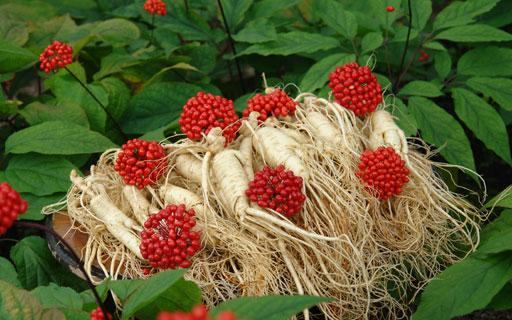
Considering that ginseng grows very slowly for the first 2-3 years, you can buy plant seedlings for planting. Roots that are usually sold are 1, 2, or 3 years old. Planted in the ground at the end of September, buried five centimeters into the ground. When planting seedlings, the final result can be achieved two to three years faster. Caring for ginseng planted as seedlings is the same as for seedlings.
It happens that planted seedlings freeze and begin to grow only the next year. A significant disadvantage of this method is the high price of seedlings. In addition, when purchasing seedlings, it is worth asking about the type of ginseng you are purchasing. Since American ginseng is sold very often. It is more hardy and frost-resistant than the Far Eastern one, but less useful.
In the natural environment of the Far Eastern taiga, coniferous and deciduous trees grow next to ginseng. Lianas of Schisandra chinensis and actinidia.Taiga black grapes. If possible, plant these plants near ginseng in the garden. Avoid growing nearby aspen and whitebark fir.
Laying a bed in the forest
You can also start a ginseng plantation in a wild forest. To do this, choose a gentle forest slope. Loosen the soil well, remove roots and remaining branches. Lay the roots almost horizontally, with the top part downward. Distance 70 cm. Cover with a 5 cm layer of soil. Do not water.
If you plant young roots weighing no more than 10 grams, they take on the appearance of wild roots; if you plant larger seedlings, the roots remain “plantation”. In the Ussuri taiga, planting secret forest plots with ginseng has a long tradition. There is still a legend about the ginseng plantation that Dersu Uzala gave to the explorer of the Ussuri region V.K. Arsenyev. In the 18th and 19th centuries in the taiga, the Chinese planted plots ranging from 20 plants to several thousand.
Diseases and pests of ginseng
In the wild, ginseng almost never gets sick. When growing ginseng in the garden, it may be threatened by:
- Anthracosis - affects a plant of any age, occurs in direct sunlight, the leaves become covered with spots. To prevent infection of neighboring plants, spray with Bordeaux mixture.
- Fusarium - the stem turns brown and rots, the seedlings wither, the roots are affected, spray with a solution of potassium permanganate.
- Aphids, mites - treat with a solution of tobacco and soap.
For preventing damage slugs, beetles, mole crickets, collect them manually, and set special traps.
As a rule, amateur gardeners start by growing just a few ginseng bushes. As you gain experience, the beds expand.Regular cultivation of ginseng, even on one hundred square meters of garden plot, gives a good profit from the sale of seeds and roots.
If we consider growing ginseng as a business project, it is important to remember that the first result will be obtained no earlier than in five to seven years. Although plantation ginseng has one and a half times less healing power than wild ginseng, medicinal tinctures from the root grown by yourself will save you from many diseases and prolong youth and health.
Features of growing ginseng in the video:
Interesting information about the vegetable garden

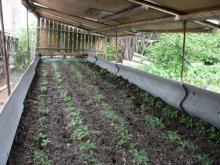


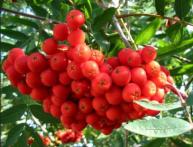
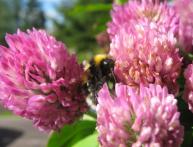

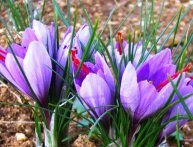
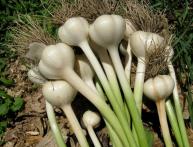
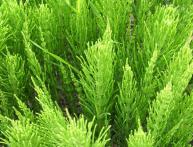

Comments
I heard and talked about the almost miraculous healing properties of ginseng, the “golden root,” back in my youth. It was news to me that it is cultivated culturally here in Ukraine. Interested.
I always knew that ginseng can be found in the taiga and only in the wild. This is the first time I’ve learned that it can be grown artificially. Quite educational.
I will sell my former successful ginseng farm together with an estate of 30 acres in the resort village of Pukhovka, Brovary district.
I will help restore the “Tsar of Plants” nursery. I’ll tell you all the secrets, as well as the special method of growing in flowerpots, patented by me.
We can cooperate. The root of longevity is very rare in Ukraine. This healing plant is not an easy plant to grow, but it is a profitable business.
Pavel Mikhailovich (098) 493-25-84